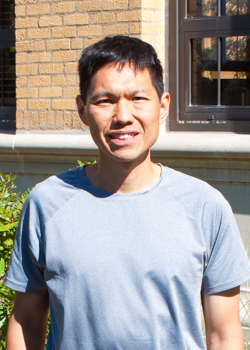Two NSSPI graduate students will be walking across the stage to receive their degrees this August. Both will be earning their Master’s of Science in Nuclear Engineering.

Heukjin Boo
Adviser: Dr. Sunil Chirayath
Master’s of Science in Nuclear Engineering
Abstract: The objective of this project study is to analyze the non-uniformity of used fuel assembly nuclide compositions and to estimate the effect of this non-uniformity in Pu accountancy using the Pu-to-244Cm ratio method for pyroprocess. In order to estimate the nuclide compositions as a function of axial and radial location in used fuel, simulation of fuel burnup is performed using Monte Carlo N-Particle 6 (MCNP6) code. The simulation model used is a one-eighth model of a 17×17 fuel assembly which is divided into 9 axial and 2 radial meshes for each fuel rod. The axial and radial non-uniformities of nuclide compositions of used fuel obtained from the MCNP6 code burnup simulation are analyzed. The axial neutron flux distribution is found to play an important role in the axial non-uniformity of nuclide compositions. In addition, the rim (edge) effect causes the radial distribution of the non-uniformity. Therefore, the Pu-to-244Cm ratio varied in the fuel depending on the location. Hence, the Pu-to-244Cm ratio method used in plutonium accounting will get affected. Depending on where the samples are chosen from the chopped pieces in estimating the Pu-to-244Cm ratio at the head-end of the pyroprocess, the uncertainties due to non-uniformity can negatively impact the accuracy of the plutonium accounting method. However, if the used fuel powders from the voloxidation step in pyroprocess are used as samples for the Pu-to-244Cm ratio method, the uncertainties are found to be small. In addition to estimating plutonium accounting uncertainty due to the used fuel nuclide composition non-uniformity, error propagation through the key-pyroprocesses (the electrolytic reduction, the electrorefining, and the electrowinning ) are performed to calculate the Material Unaccounted For (MUF) in the assumed Material Balance Area (MBA) for the pyroprocessing facility. The available throughput to fulfill the IAEA (International Atomic Energy Agency) nuclear material safeguards criteria is also estimated for a given Material Balance Period (MBP). Based on the observations, although the variance of nuclide compositions exists in used fuel, it can be concluded that the non- uniformity of nuclide compositions in a used fuel does not influence the Pu material accountability using the Pu-to-244Cm ratio method in pyroprocessing when samples are taken from the voloxidation step of the pyroprocess.

Miles Chen
Adviser: Dr. Craig Marianno
Master’s of Science in Nuclear Engineering
Abstract: Emergency responders could be exposed to loose radioactive material during a mission. As part of a research project at Texas A&M University, 18F was sprayed in a small area where an Exercise Participant (in protective gear) conducted simulated search activities. A dose assessment tool developed by the researchers was used to estimate doses to the Radiation Worker (mixer and sprayer) and Exercise Participant. The current project aimed to validate the assessment methodology by comparing actual and estimated doses of the two personnel. In the scenario, the Radiation Worker injected and mixed 200 MBq Fludeoxyglucose 18F (FDG) with 470 ml H2O in a commercial weed sprayer. The solution was distributed evenly over a 3 m x 3 m region in 5 min. After 36 min of evaporation, the Exercise Participant entered the area for a total of 22 min. Actual whole body (WB) doses from optically stimulated luminescence (OSL) were 10 ± 2 μSv for both the Radiation Worker and Exercise Participant. WB digital personal dosimeter readings were 4.3 ± 0.4 μSv and 3.3 ± 1.0 μSv for the Radiation Worker and Exercise Participant, respectively. Actual extremity doses to Radiation Worker’s finger dosimeters were < 100 μSv (minimum detectable limit), and to exercise participant’s leg OSL was < 10 μSv. Preliminary dose assessment method was conservative for the Radiation Worker and conservatively accurate for the Exercise Participant. The predicted Radiation Worker doses were 90 μSv to the whole body (WB) and 744 μSv to the hand, both ≫2𝜎 above the actual exposures. The Exercise Participant’s estimated doses were 7 μSv to the WB and 15 μSv to the knee area, which were in the same order of magnitude as the actual. Refined dose assessment aimed to predict personnel exposure more exactly and was shown to be accurate. The predicted Radiation Worker doses were 2.8 ± 0.8 μSv to the WB and 21.8 ± 7.5 μSv to the hand. The Exercise Participant’s estimated doses were 5.2 ± 0.5 μSv to the WB and 13.4 ± 1.2 μSv to the knee area. Estimated whole body doses were in the same order of magnitude as the actual doses for both the Radiation Worker and the Exercise Participant. Comparing estimated extremity dose to the actual value was difficult, due to exposures having been below detectable limits, however, there were no obvious inconsistencies.